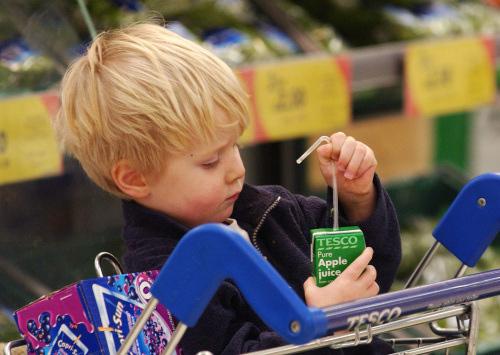It's true _ apple juice can pose a risk to your health. But not necessarily from the trace amounts of arsenic that people are arguing about.
Despite the government's consideration of new limits on arsenic, nutrition experts say apple juice's real danger is to waistlines and children's teeth. Apple juice has few natural nutrients, lots of calories and, in some cases, more sugar than soda has. It trains a child to like very sweet things, displaces better beverages and foods, and adds to the obesity problem, its critics say.

``It's like sugar water,'' said Judith Stern, a nutrition professor at the University of California, Davis, who has consulted for candy makers as well as for Weight Watchers. ``I won't let my 3-year-old grandson drink apple juice.''
Many juices are fortified with vitamins, so they're not just empty calories. But that doesn't appease some nutritionists.
``If it wasn't healthy in the first place, adding vitamins doesn't make it into a health food,'' and if it causes weight gain, it's not a healthy choice, said Karen Ansel, a registered dietitian in New York and spokeswoman for the American Dietetic Association.
The American Academy of Pediatrics says juice can be part of a healthy diet, but its policy is blunt: ``Fruit juice offers no nutritional benefit for infants younger than 6 months'' and no benefits over whole fruit for older kids.
Kids under 12 consume 28 percent of all juice and juice drinks, according to the academy. Nationwide, apple juice is second only to orange juice in popularity. Americans slurp 267 ounces of apple juice on average each year, according to the Food Institute's Almanac of Juice Products and the Juice Products Association, a trade group. Lots more is consumed as an ingredient in juice drinks and various foods.
Only 17 percent of the apple juice sold in the U.S. is produced here. The rest comes from other countries, mostly China, Argentina, Chile and Brazil, the association says.
Television's Dr. Mehmet Oz made that a key point a few months ago when he raised an alarm _ some say a false alarm _ over arsenic in apple juice, based on tests his show commissioned by a private lab. The Food and Drug Administration said that its own tests disagreed and that apple juice is safe.
However, on Wednesday, after Consumer Reports did its own tests on several juice brands and called along with other consumer groups for stricter standards, the FDA said it will examine whether its restrictions on the amount of arsenic allowed in apple juice are stringent enough.
Some forms of arsenic, such as the type found in pesticides, can be toxic and may pose a cancer risk if consumed at high levels or over a long period.
All juice sold in the United States must be safe and meet U.S. standards, said Pat Faison, technical director for the juice association. As for making good nutrition choices, ``a lot of the information that people need about fruit juices is on the label,'' she said.
So what's on those labels?
Carbohydrates, mostly sugars, in a much higher concentration than in milk. Juice has a small amount of protein and minerals and lacks the fiber in whole fruit, the pediatrics academy notes.
Drinking juice delivers a lot of calories quickly so you don't realize how much you've consumed, whereas you would have to eat a lot of apples to get the same amount, and ``you would feel much, much more full from the apples,'' Ansel said.
``Whole fruits are much better for you,'' said Dr. Frank Greer, a University of Wisconsin, Madison, professor and former head of the pediatrics academy's nutrition committee.
He noted that the WIC program _ the U.S. Department of Agriculture's nutrition program for Women, Infants and Children _ revised its rules in 2005 to replace juice with baby food fruits and vegetables for children over 6 months. More than half of all infants born in the U.S. are eligible for WIC, and the government ``really cut back severely on the ability of mothers to get fruit juices'' through the program, Greer said.
If you or your family drinks juice, here is some advice from nutrition experts:
_Choose a juice fortified with calcium and vitamin D-3.
_Give children only pasteurized juice _ that's the only type safe from germs that can cause serious disease.
_Don't give juice before 6 months of age, and never put it in bottles or covered cups that allow babies and children to consume it throughout the day, which can cause tooth decay. For the same reason, don't give infants juice at bedtime.
_Limit juice to 4 to 6 ounces per day for children ages 1 to 6, and 8 to 12 ounces for those ages 7 to 18.
_Encourage kids to eat fruit.
_Don't be swayed by healthy-sounding label claims. ``No sugar added'' doesn't mean it isn't full of naturally occurring sugar. And ``cholesterol-free'' is silly _ only animal products contain cholesterol.
<한글 기사>
"비만부르는 사과주스 대신 사과통째로 드세요"
전문가 "굳이 마시려면 칼슘•비타민함량 높은 것 택해야"
보건 당국은 시중에서 팔리는 사과주스에 포함된 비소(砒素)량을 규제하지만 영양 전문가들은 사과주스의 진짜 문제가 비만과 충치 유발에 있다고 지적한다.
시판되는 사과주스에는 천연 영양소가 거의 없는 반면 칼로리는 높고, 일부의 경우 사이다보다 당분 함량이 더 높기 때문이다.
특히 어린이들을 단 음식을 선호하도록 길들이는 통에 어린이 비만의 한 원인이 되기도 한다고 전문가들은 지적하고 있다.
캘리포니아대학 데이비스캠퍼스의 영양학 전공 주니스 스턴 교수는 "사과주스는 설탕물과 매한가지"라며 "나는 내 세살짜리 손자에게 사과주스를 주지 않을 것"이라 고 말했다.
사과주스에 비타민이 풍부하다는 주장에 대해서도 미 영양학협회 캐런 안셀 대변인은 "어떤 식품이 건강에 좋지 않다면 비타민 함량을 늘린다 한들 건강식품으로 탈바꿈되지는 않는다"며 "또한 그 식품이 비만의 원인을 제공한다면 건강한 선택이 아니다"라고 말했다.
특히 미국 소아과아카데미는 "6개월 미만 유아에게 사과주스를 포함한 과일주스 는 어떤 영양상의 이익도 제공하지 않는다"고 단언했다.
전문가들은 또 과일주스는 당분이 많은 반면 단백질과 미네랄은 적고, 생과일에 풍부한 섬유질 역시 부족하다고 지적하면서 생과일을 그대로 먹는 편이 좋다고 권고 한다.
생과일을 먹을 경우 주스를 마실 때 보다 훨씬 쉽게 포만감을 느끼기 때문에 과 일에 포함된 당분으로 인한 비만걱정도 상당부분 덜어준다고 전문가들은 강조했다.
전문가들은 그래도 꼭 주스를 마시고 싶다면 칼슘과 비타민 D-3가 강화된 주스를 선택하고, 아이들에게는 병원균 차단 차원에서 저온살균된 주스를 줄 것을 조언 한다.
또 충치 예방을 위해 만 1~6세에게는 하루 113~170g(4~6온스), 7~18세에게는 22 7~340g(8~12온스)으로 각각 섭취량을 제한하고, 자기전에는 주지 말라고 당부한다.
또 건강에 좋다는 과일주스 광고에 현혹되지 말 것을 주문했다. `당분이 추가 돼 있지 않다'는 문구는 과일에 함유된 천연 당분까지 없다는 뜻은 아니며, `콜레스 트롤이 없다'는 문구는 콜레스트롤이 동물성 식품에만 있기 때문에 `사기'나 다름없 다는 것이다.
업계 통계에 따르면 미국인의 1인당 연 평균 사과주스 소비량은 약 7.6kg(267온스)에 달하는데, 특히 어린이가 주 소비층인 것으로 조사되고 있다.
소아과아카데미에 따르면 12세 미만이 현재 미국내 전체 과일주스류 판매량의 2 8%를 책임지고 있다.
한편 미국에서 팔리는 사과주스의 17%만 국산이고, 대부분 중국, 아르헨티나, 칠레, 브라질 등에서 생산된 것이라고 주스상품협회는 밝혔다.
"비만부르는 사과주스 대신 사과통째로 드세요"
전문가 "굳이 마시려면 칼슘•비타민함량 높은 것 택해야"
보건 당국은 시중에서 팔리는 사과주스에 포함된 비소(砒素)량을 규제하지만 영양 전문가들은 사과주스의 진짜 문제가 비만과 충치 유발에 있다고 지적한다.
시판되는 사과주스에는 천연 영양소가 거의 없는 반면 칼로리는 높고, 일부의 경우 사이다보다 당분 함량이 더 높기 때문이다.
특히 어린이들을 단 음식을 선호하도록 길들이는 통에 어린이 비만의 한 원인이 되기도 한다고 전문가들은 지적하고 있다.
캘리포니아대학 데이비스캠퍼스의 영양학 전공 주니스 스턴 교수는 "사과주스는 설탕물과 매한가지"라며 "나는 내 세살짜리 손자에게 사과주스를 주지 않을 것"이라 고 말했다.
사과주스에 비타민이 풍부하다는 주장에 대해서도 미 영양학협회 캐런 안셀 대변인은 "어떤 식품이 건강에 좋지 않다면 비타민 함량을 늘린다 한들 건강식품으로 탈바꿈되지는 않는다"며 "또한 그 식품이 비만의 원인을 제공한다면 건강한 선택이 아니다"라고 말했다.
특히 미국 소아과아카데미는 "6개월 미만 유아에게 사과주스를 포함한 과일주스 는 어떤 영양상의 이익도 제공하지 않는다"고 단언했다.
전문가들은 또 과일주스는 당분이 많은 반면 단백질과 미네랄은 적고, 생과일에 풍부한 섬유질 역시 부족하다고 지적하면서 생과일을 그대로 먹는 편이 좋다고 권고 한다.
생과일을 먹을 경우 주스를 마실 때 보다 훨씬 쉽게 포만감을 느끼기 때문에 과 일에 포함된 당분으로 인한 비만걱정도 상당부분 덜어준다고 전문가들은 강조했다.
전문가들은 그래도 꼭 주스를 마시고 싶다면 칼슘과 비타민 D-3가 강화된 주스를 선택하고, 아이들에게는 병원균 차단 차원에서 저온살균된 주스를 줄 것을 조언 한다.
또 충치 예방을 위해 만 1~6세에게는 하루 113~170g(4~6온스), 7~18세에게는 22 7~340g(8~12온스)으로 각각 섭취량을 제한하고, 자기전에는 주지 말라고 당부한다.
또 건강에 좋다는 과일주스 광고에 현혹되지 말 것을 주문했다. `당분이 추가 돼 있지 않다'는 문구는 과일에 함유된 천연 당분까지 없다는 뜻은 아니며, `콜레스 트롤이 없다'는 문구는 콜레스트롤이 동물성 식품에만 있기 때문에 `사기'나 다름없 다는 것이다.
업계 통계에 따르면 미국인의 1인당 연 평균 사과주스 소비량은 약 7.6kg(267온스)에 달하는데, 특히 어린이가 주 소비층인 것으로 조사되고 있다.
소아과아카데미에 따르면 12세 미만이 현재 미국내 전체 과일주스류 판매량의 2 8%를 책임지고 있다.
한편 미국에서 팔리는 사과주스의 17%만 국산이고, 대부분 중국, 아르헨티나, 칠레, 브라질 등에서 생산된 것이라고 주스상품협회는 밝혔다.






![[From the Scene] Monks, Buddhists hail return of remains of Buddhas](http://res.heraldm.com/phpwas/restmb_idxmake.php?idx=644&simg=/content/image/2024/04/19/20240419050617_0.jpg&u=20240419175937)








![[From the Scene] Monks, Buddhists hail return of remains of Buddhas](http://res.heraldm.com/phpwas/restmb_idxmake.php?idx=652&simg=/content/image/2024/04/19/20240419050617_0.jpg&u=20240419175937)

![[KH Explains] Hyundai's full hybrid edge to pay off amid slow transition to pure EVs](http://res.heraldm.com/phpwas/restmb_idxmake.php?idx=652&simg=/content/image/2024/04/18/20240418050645_0.jpg&u=20240419100350)

![[Today’s K-pop] Illit drops debut single remix](http://res.heraldm.com/phpwas/restmb_idxmake.php?idx=642&simg=/content/image/2024/04/19/20240419050612_0.jpg&u=)